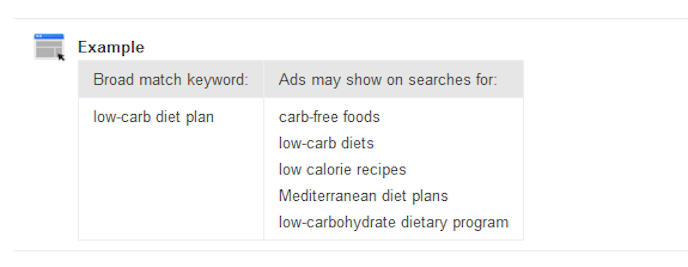Google Adwords continues to pioneer PPC (pay-per-click) marketing and they continue to tweak their network to increase growth and relevancy. With their search algorithm going through updates, it only makes sense that they tweak their ad network so they work hand in hand. There’s no point in changing the way Google displays search results and having an advertising network that doesn’t perform up to standard. However, there are a few strategies you can implement into your campaign to make it more effective. Why? Simple,
Even though they continue to make improvements to their ad network, you can still fall victim to basic user errors made during the ad set up. Here is the first optimization strategy to implement the next time you set up your campaign.
Start by avoiding Broad Matched Keywords…
What are Broad Matched Keywords?
When using broad match, you’re setting up your ads to automatically run on different variations of your keyword. This means even if you haven’t specified keywords within your campaign, Google will automatically determine other keywords that are a good fit for your campaign. Many will argue having such a setup will attract more visitors, however, personally, I think it will attract unwanted visitors, especially if you’re trying to narrow down a target audience.
Next,
Broad match is the default match type that all your keywords are assigned if you don’t specify another match type (exact match, phrase match, or negative match).
Having such a setup will require more of a budget as you might get visitors who are not directly interested in your product or service. Here’s an example

Why Avoid Them in Your Campaign?
The above examples outline how Google broad match automatically generates a list of keywords for your campaign. There are more disadvantages to broad matches.
First, Google generating list of keywords means some will not be relevant to your business, which is pushing you away from your ultimate goal of a high CTR. It will also cost you more money because some clicks will come from non-relevant people. Having irrelevant keywords within your campaign can even cause you to get lower clicks as people won’t find the ad attractive. The ultimate effect is a lower CTR (click-through-rate) for the specific keyword being displayed. A low CTR means the average quality score for the keyword is lowered, meaning Google will require someone to place a higher bid to stop it from being disabled within the ad network altogether.
There has been much debate about how Google differentiates quality score between advertisers and if they base it on the total performance of individual ads. If this is the case, a low quality score can have you paying more for a keyword compared to someone else if they have performed better. The funny thing is, this whole chain effect is triggered by simply running an ad on a “broad match†system.
Next,
You have another problem, which people don’t calculate until the end of the month. This causes a drop in advertising revenue and the overall budget. When your ad is displayed for irrelevant keywords, you have a lower chance of converting a visitor into a sale. Many online shoppers don’t have too much experience or knowledge about the product they are searching for. This forces them to click ads that broadly match their requirement. It’s only when they visit the page that they make a buying decision. However, your campaign being displayed for irrelevant keywords can result in a click, costing you money and not converting into a sale or lead. You end up paying money for a campaign that is not producing results. Depending on the bid per keyword, you end up paying a lot of money per keywords without getting anything in return (leads, sales, and profits).
It’s important that you implement a few steps to avoid this problem from the beginning. Implement the following solutions before going live with your ad.
First, this tweak should be added to both new and existing Google Adwords campaigns. Start with phrase-matched and exact-matched keywords. Having this setup will allow you to control when your campaign will appear and is much more targeted. Before setting up your ad, do some extensive keywords research because search volume is based on Google’s keyword data. Next, if your campaign does not perform well with phrase-matched and exact-matched keywords, then you can consider adding some broad-matched keywords; however, it’s important to track performance from the beginning. If they are generating results, you can keep them within your campaign, however, if not, then shift them around until you find a combination that works.
Secondly,
As you learned above, remove keywords that lower your quality score and decrease your CTR. Not keeping an eye on low performing keywords might effect your bid rate and the frequency that Google shows your ads to visitors. In the beginning, set up a custom run date so your ad automatically turns off. During this period, skim through, looking over stats and tweaking performance going forward.
Wrapping It Up…
Over the next several weeks, I’ll be posting more optimization strategies. However, I’ll start with keyword research as this is the most important. A solid keyword foundation is the difference between a winning and losing campaign. Again, everything requires testing, but once you have something that works with a high CTR, you can convert a simple campaign into enormous profits.